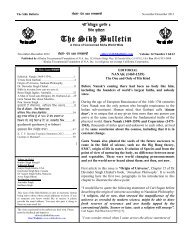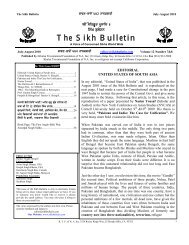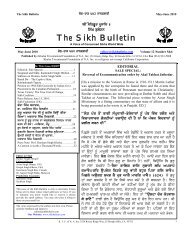hirmMdr ik drbwr swihb - The Sikh Bulletin
hirmMdr ik drbwr swihb - The Sikh Bulletin
hirmMdr ik drbwr swihb - The Sikh Bulletin
Create successful ePaper yourself
Turn your PDF publications into a flip-book with our unique Google optimized e-Paper software.
<strong>The</strong> S<strong>ik</strong>h <strong>Bulletin</strong> mwG-Pgx 542 nwnkSwhI January-February 2011<br />
Masand system, the elimination of personal Guruship<br />
and the recognition of the authority of the ‘Panth’<br />
appeared to be radical measures even though they were<br />
rooted in the past. “ (Page 348)<br />
Daulat Rai, and Arya Samaji Historian of the west<br />
Panjab, In his book ‘Sahib-E- Kamal Guru Gobing<br />
Singh (1993 edition) writes: -<br />
“It is extremely rare if not altogether impossible to find<br />
all the good qualities in one man. But the Guru was an<br />
embodiment of all round perfection. He was a poet, a<br />
religious leader, a religious and social reformer, an<br />
excellent planner and counselor and superb general. He<br />
was a poet whose verse was forceful and vibrant with<br />
emotions of every kind, and highly eloquent. As a<br />
reformer in the social and religious spheres he had no<br />
peer. In the battle-field he was a dauntless general<br />
unperturbed by the turn of events. He was a sagacious<br />
and far-sighted counselor, a true lover of his country, an<br />
unflagging champion of his people, an unrivalled<br />
martyr of his country.” ( Page 154.)<br />
“ <strong>The</strong> Guru was able to infuse new blood and vigor in<br />
dying Hindu Nation. From Amongst the cowardly and<br />
supine Hindus, he created a new breed of virile and<br />
valiant people, the Khalsa, filled with the spirit of<br />
selfless service and self-sacrifice for the good humanity<br />
and the Glory of Akal.”( Page 175.)<br />
*****<br />
< siqgur pRswid ]<br />
is~K dI Ardws Aqy BgOqI<br />
Dalbir Singh [ds@dioptres.com]<br />
During the last two sessions held on 7 th October and 4 th<br />
November 2007, Dr. Tejpal Singh has already<br />
explained the importance and significance of the S<strong>ik</strong>h<br />
Ardaas as collectively accepted by the Guru Panth by<br />
virtue of SGPC’s Resolution No. 97 dated 3 rd February<br />
1945, reproduced in the S<strong>ik</strong>h Reht Maryada ‘as<br />
amended subsequently’ (when?). However, due to time<br />
constraints, certain queries could not be taken up for<br />
discussion. Accordingly, I have been asked to<br />
participate so that discussion may proceed further.<br />
At the outset, I wish to share with the audience that<br />
“despite some ambiguities” now being raised, I have<br />
been following “Ardaas” twice a day after reciting<br />
Nitnem, as mentioned in the S<strong>ik</strong>h Reht Maryada.<br />
Whatever, comments are expressed here by me are for<br />
the sake of discussion only (why not to decide the<br />
issue?) because no individual or group has the<br />
Authority to modify SRM except by the Guru Panth<br />
(where is Panth that follows Guru Granth Sahib?) that<br />
too on the basis of collective Resolution passed by the<br />
Sarbat Khalsa (define this term) and officially<br />
conveyed by the SGPC (Is SGPC reliable? Why<br />
reverting its decision regarding Nanakshahi Calender?)<br />
Under Heading “Ardaas”, footnote is given in the S<strong>ik</strong>h<br />
Reht Maryada, which reads as below:<br />
# ieh Ardws dw nmUnw hY [ “ipRQm BgOqI” vwly Sbd Aqy<br />
‘nwnk nwm’ vwlIAW AMqlIAW do qukW ivc qbdIlI nhIN ho<br />
skdI [ (svwl pYdw huMdw hY <strong>ik</strong> koeI isK, j`Qydwr jW srb`q<br />
Kwlsw <strong>ik</strong>sy nUM “nwnk” pd vrqx dI iejwzq dy skdw hY?)<br />
Aqy {jy vwr durgw, gurU <strong>swihb</strong> dI <strong>ik</strong>rq hY qW hor koeI<br />
ibMdIAW <strong>ik</strong>vyN lgw skdy hn?}<br />
It is thus essential to know why “Pritham<br />
Bhagauti…”, which is not enshrined in Guru Granth<br />
Sahib, was accorded the status of “Gurbaani, Divine<br />
Word” ?<br />
Various S<strong>ik</strong>h Authors and Scholars have pointed out<br />
that first stanza of “Ardaas” has been found to be lifted<br />
from “Vaar Durga Kee”, which has (55) Stanzas under<br />
Serial Nos. 1 to 55. Here, I will reproduce only two<br />
Stanzas i.e. First and the last though all Stanzas need<br />
to be studied (describing Devi Durga vs Demons’<br />
wars):<br />
{inqnym gutkw / is~K rihq mrXwdw}<br />
vwr durgw kI < vwihgurU jI kI &qih ]<br />
< siqgur pRswid sRI BgOqI jI shwie ]<br />
sRI BgauqI jI shwie vwr sRI BgOqI jI kI pwqSwhI 10 ]<br />
AQ vwr durgw kI ilKHXqy ipRQm BgOqI ismir kY gur<br />
pwiqswhI 10 nwnk leIN iDAwie]<br />
pauVI iPr AMgd gur qy Amrdwsu<br />
pRQim BgauqI ismrkY rwmdwsY hoeIN shwie ]<br />
gurU nwnk leI iDAwie [ Arjn hrgoibMd no ismrO<br />
AMgd gur qy Amrdws sRI hirrwie ] sRI hir<strong>ik</strong>Sn<br />
rwmdwsY hoeI shwie[ iDAweIAY ijs ifTy siB duiK jwie]<br />
Arjun hirgoibMd no qyg bhwdr ismirAY<br />
ismro sRI hir rwie [ Gr nau iniD AwvY Dwie ]<br />
K. T. F. of N. A. Inc. 3524 Rocky Ridge Way, El Dorado Hills, CA. 95762 13

















